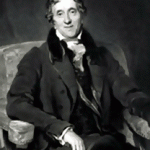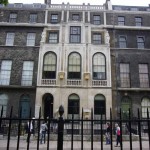Though a far cry from the traditional set up of a museum as everything is held in a man’s house, the Sir John Soane Museum showcases aspects of the British identity quite well. In fact, the museum’s success in its portrayal of the British identity might be attributed to the fact that it is in Sir John Soane’s house. The placement demands that attention be paid to the man and the object rather than just the objects on display. The objects he collected are incredible- beautiful, intricate, and plentiful. Still, one would find difficulty leaving the house without considering how the objects, the man, and Britain all tie together.

Sir John Soane
Sir John Soane, an architect most famous for his work on the exterior of the Bank of England, understood the importance of inheritance in the British social set up. The son of a mason, he was in good company for improving his skills in the building trade. If he was content with being just another mason or even just another architect though, I wouldn’t have anything to write about in this post; that is, his collection, his museum, his legacy, his influence- none of this would be possible. His social stature needed to improve. Sir John Sloane lived and worked during the Georgian era, a time known as the “Age of Aristocracy” in which the British aristocracy enjoyed a level of prominence in society. While wars of independence and revolutions for social equality raged in other lands, the English social scene continued to favor the upper classes that the others were rebelling against. Understanding the importance that his social stature had in such a society, Sir John Soane married into money in 1784. This marriage gave him the social status that enabled him to reach a more elite class of customers and, as a result, be involved with more impressive and monumental projects. His talent alone was noteworthy. Before he married, he had already won many awards in architecture, traveled to Italy to perfect his craft, and had began compiling images for a publication that would come out in 1788. I don’t mean to belittle his talent at all. Still, it wasn’t until after his marriage that he started to design more major projects including his most famous work on the Bank of England. There has to be a link between the wealth and stature he acquired in his marriage and the timing of his more famous works. Yes, he was good but you have to be great to be sought after to work on such large-scale projects as the Bank of England. Why was he sought after for such projects? I would argue that the answer lies in the fact that people of a certain social circle knew his name because of his social status in London.
Soane’s displaying his possessions to the public can be seen then as a key portrayal of the British identity. He was able to collect all of these remarkable objects because he was wealthy and influential enough to even be considered as a possible owner in the first place. His social climbing, in my opinion, played a major part in getting him to that status. Let’s remember that Sir John Soane didn’t just display these impressive objects in a building (something he could have easily crafted given his profession). He displayed everything in his house and, in doing so, put his house and himself on display as well. His life became part of the exhibit. So truly his life must be considered as much as any of the objects in the museum upon reflection. The statues were beautiful but does anyone need that many? Short answer: no. Sir John Soane seemed to think differently though. For this reason, his seems to have an understanding of the importance of showing off one’s social status in the English society. He needed people to understand just how well off he was. What better way to accomplish such a thing than to display impressive object after impressive object in the context of your home ?

Outside of Sir John Soane's home
Interestingly enough, the museum has been and continues to be free of charge to the public as was declared by Sir John Soane the way it should be. This fare gives every person the same opportunity to visit the museum as the next. Was this a way in which to thwart the social fixtures that seemed to consume his society? Or was it a way to show off on the most massive scale possible? I’m not sure. But this college student certainly appreciated the fee. But no matter what the cost was to get into the museum, I think its impossible to only call it that. It’s more than a museum. It’s a portrayal of a man’s life and the society he tried so hard to impress.

1 response so far ↓
mliberty // Sep 12th 2009 at 19:13
Someone has been spending too much time working on their walking tour… way to pick a title only three other people and possibly Qualls will fully appreciate.
In case you guys were wondering, Audrey’s title is based off of Virginia Woolf’s essay “A Room of One’s Own.” For more information come on our tour tomorrow(Sunday) at 9:30 and hear all about it! (This is not a plug for our walking tour…unless it works and now you come…)
You must log in to post a comment.